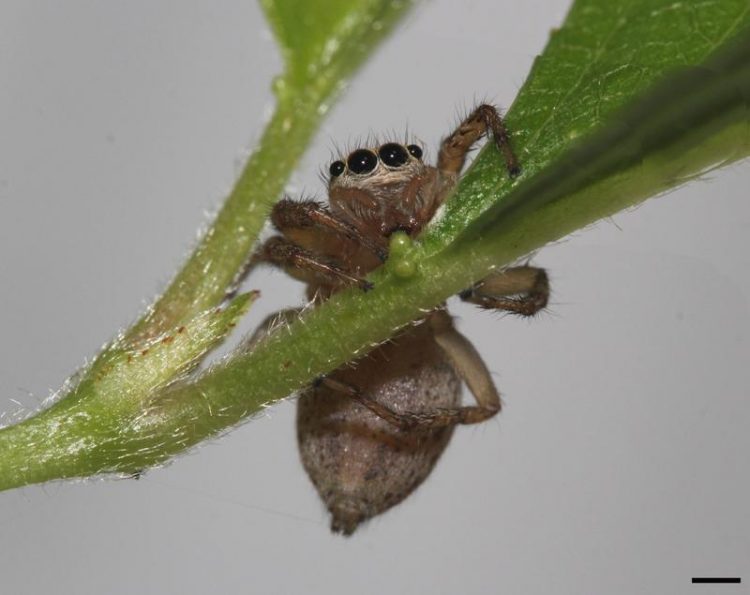More Than Bugs: Spiders Also Like to Eat Vegetarian

Adult female jumping spider Maevia inclemens drinking nectar at the extrafloral nectaries of a Prunus shrub. It presses its mouthparts into the nectary opening imbibing nectar. David E. Hill, Peckham Society, Simpsonville, South Carolina
Although traditionally viewed as a predator of insects, researchers have become increasingly aware that spiders are not exclusively insectivorous. Some spiders have been shown to enrich their diets by occasionally feasting on fish, frogs or even bats. A new study by Zoologists from the University of Basel, Brandeis University (US) and Cardiff University (UK) now shows evidence of spiders eating plant food as well.
Plants as diet supplement
The researchers gathered and documented numerous examples from literature of spiders eating plant food. According to their systematic review, spiders from ten families have been reported feeding on a wide variety of different plant types such as trees, shrubs, weeds, grasses, ferns or orchids. They also show a diverse taste when it comes to the type of plant food: nectar, plant sap, honeydew, leaf tissue, pollen and seeds are all on the menu.
The most prominent group of spiders engaged in plant-eating are Salticidae – a diurnal spider family with characteristically large anterior median eyes. Salticidae were attributed with up to 60 percent of all plant-eating incidents documented in this study. As plant-dwelling, highly mobile foragers with excellent capability to detect suitable plant food, these spiders seems to be predestined to include some plant food in their diets.
Global feeding behavior
Spiders feeding on plants is global in its extent, as such behavior has been reported from all continents except Antarctica. However, it is documented more frequently from warmer areas. The researchers suggest that this might be due to the fact that a larger number of the reports relate to nectar consumption which has its core distribution in warmer areas where plants secreting large amounts of nectar are widespread.
“The ability of spiders to derive nutrients from plants is broadening the food base of these animals; this might be a survival mechanism helping spiders to stay alive during periods when insects are scarce”, says lead author Martin Nyffeler from the University of Basel in Switzerland. “In addition, diversifying their diet with plant is advantageous from a nutritional point of view, since diet mixing is optimizing nutrient intake.” However, the extent to which the different categories of plant food contribute to the spiders’ diet is still largely unexplored.
Original source
Martin Nyffeler, Eric J. Olson, William O.C. Symondson
Plant-eating by spiders
Journal of Arachnology (2016) 44: 15-27 | doi: 10.1636/P15-45.1
Further information
PD Dr. Martin Nyffeler, University of Basel, Department of Environmental Sciences, Tel. +41 61 702 07 03, email: martin.nyffeler@unibas.ch
https://www.unibas.ch/en/News-Events/News/Uni-Research/More-Than-Bugs–Spiders-A…
Media Contact
All latest news from the category: Life Sciences and Chemistry
Articles and reports from the Life Sciences and chemistry area deal with applied and basic research into modern biology, chemistry and human medicine.
Valuable information can be found on a range of life sciences fields including bacteriology, biochemistry, bionics, bioinformatics, biophysics, biotechnology, genetics, geobotany, human biology, marine biology, microbiology, molecular biology, cellular biology, zoology, bioinorganic chemistry, microchemistry and environmental chemistry.
Newest articles

A universal framework for spatial biology
SpatialData is a freely accessible tool to unify and integrate data from different omics technologies accounting for spatial information, which can provide holistic insights into health and disease. Biological processes…

How complex biological processes arise
A $20 million grant from the U.S. National Science Foundation (NSF) will support the establishment and operation of the National Synthesis Center for Emergence in the Molecular and Cellular Sciences (NCEMS) at…

Airborne single-photon lidar system achieves high-resolution 3D imaging
Compact, low-power system opens doors for photon-efficient drone and satellite-based environmental monitoring and mapping. Researchers have developed a compact and lightweight single-photon airborne lidar system that can acquire high-resolution 3D…





















